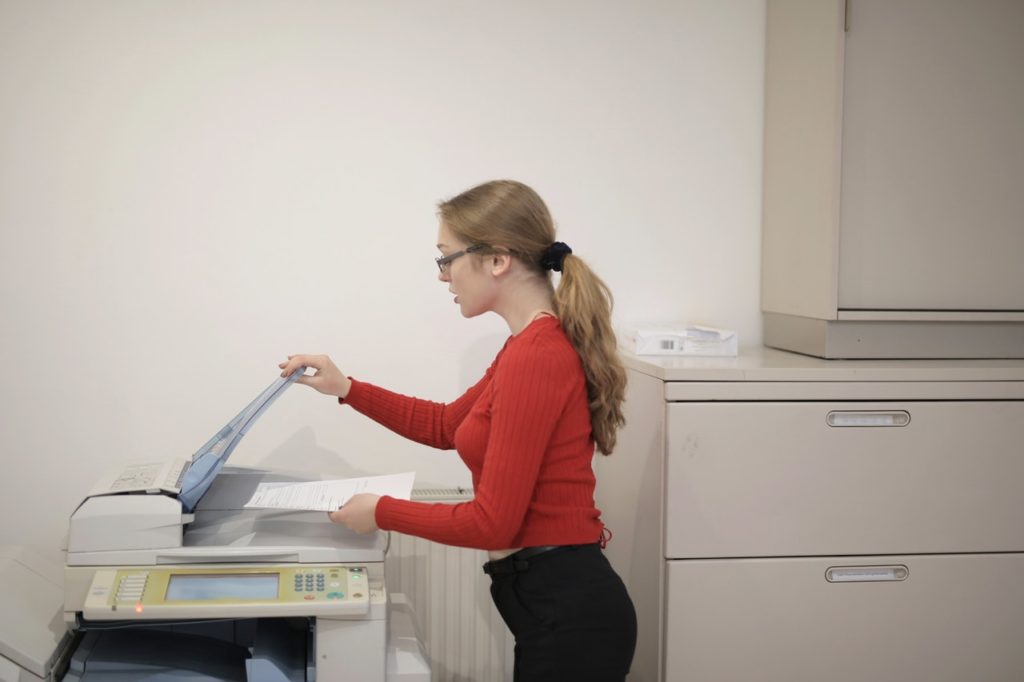
How does a photocopier work? They work because light carries energy and opposite electric charges attract.
The first principle that the photocopier relies on is that light carries energy. Light is a little difficult to understand. According to Einstein, anything that travels at the speed of light cannot have any mass. If something has mass and still travels at the speed of light, it would need infinite energy. Light obviously does travel at the speed of light, and it obviously cannot have infinite energy, which means it cannot have any mass. So, how can light have energy? Light has energy without mass because it is a wave that is transferring momentum. This momentum brings the energy. It is similar to a wave in the ocean. When a wave travels across the ocean, the same water molecules don’t stay with it all the time. The wave has momentum and it passes through the sea. The wave itself has no mass, but it has energy. Light is just like this.
The second principle the photocopier relies on is that opposite electric charges attract, which means that like charges repel each other. An electric charge is caused by the number of protons or electrons the atom has. A positive charge has a higher number of protons and a negative charge has a lower number of protons. When a positive charge and a negative charge are brought together, the extra protons in the positive charge flow to the negative charge to balance the number out, causing an attraction. When two positive charges are brought together, there are extra protons in each charge which push each other away. When two negative charges are brought together, they have fewer protons, but they have a higher number of electrons that push each other away.
So, how does a photocopier work? There are several parts that work together. There is a bright halogen light underneath the glass layer you put the document on. There is a drum that has a photoconductor wrapped around it. There are many different materials that can be used as photoconductors, but most photocopiers use selenium, germanium, or silicon. The photoconductor is kept in a dark space and is inactive until the light from the copier lands on it. It is given a positive electrical charge. Then there is the toner that will recreate the document. The toner is not ink. It is a fine, negatively charged, plastic-based powder.
When you put the document on the glass, the powerful light shines on to it. The light waves hit the document and reflect. The white parts of the paper reflect more light than the dark areas because light is absorbed by darker colors. The reflected light is directed at the drum with the photoconductor layer. When the light photons hit the photoconductor, they strip electrons from it and turn its positive charge into a negative charge. Because the black areas on the document haven’t reflected any light, there is now a representation of the document on the drum made using negative and positive electrical charges. The places with text are positively charged and the other areas are negatively charged.
Toner is introduced into the equation. The toner is a negatively charged black pigment. Because opposite forces attract and like forces repel, the toner sticks to the positively charged areas of the drum, which are the areas with the text. Positively charged paper is pressed to the drum and the negatively charged toner sticks to the paper. The charge in the paper is greater than that in the drum. The paper is then heated by something called the “fuser”, effectively melting the toner to the page. The fuser is a pair of heated rollers that the paper passes through.
These are basic photocopiers and they are slowly disappearing. Regular office photocopiers may still work in this way, but modern photocopiers are becoming more digital. They scan the image using an image-sensor chip. Then the processer in the copier produces an image file and the copier prints it in the same way as an ink jet printer. They can scan and print images in much higher resolution than regular photocopiers. They can also expand the image without much loss of quality.
The photocopier was invented in 1938 by Chester Carlson. He had a lot of trouble selling his idea because nobody could think of a reason why anybody would need to duplicate a document in an office. He finally found interest in 1944 and he started the Xerox company in 1948. His invention changed the way offices work and became a necessity in every office. Carlson became an incredibly rich man but he gave most of his money away to help people. His goal was to “die a poor man”.
So, how does a photocopier work? A photocopier works by reflecting an image of the document onto a charged photoconductive drum. A negatively charged toner sticks to the charged areas and forms an copy of the document. The toner is then fused to paper using heat. And this is what I learned today.
Sources
https://www.explainthatstuff.com/photocopier.html
https://home.howstuffworks.com/photocopier1.htm
https://en.wikipedia.org/wiki/Photocopier
https://en.wikipedia.org/wiki/Chester_Carlson
https://en.wikipedia.org/wiki/Photoconductivity
http://www.bu.edu/simulation/classes/505classnotes/PhotoCopier.pdf
